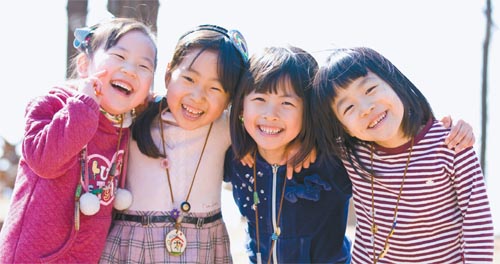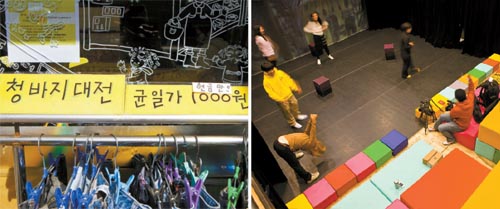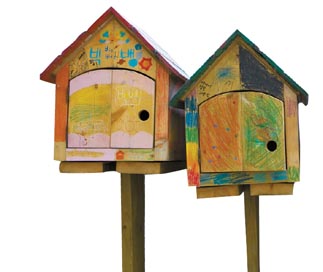In Seoul, a village where everyone knows your name

The children of Seongmi Mountain School enjoy their recess. By Kwon Hyeok-jae
Since the days of the Industrial Revolution, modern city life has often been lamented for engendering a sense of isolation and oppressiveness. Neighbors rarely interact; everybody has someplace to be.
But one neighborhood in the middle of Seoul has tried to stem the ills urban life can bring - a sort of antidote to the Bartleby the Scrivener-type of tragedy Herman Melville so hauntingly portrayed back in the 19th century.
Nestled against Mount Seongmi, a small mountain in Mapo District, western Seoul, adjacent to Hongdae, Seongmi Mountain Village has made a name for itself through its collective approach to modern life, building and operating cooperatives in an attempt to humanize the impersonal.
It all started with a day care center. Neighborhood residents became interested in a cooperative child care facility in 1994, so those interested chipped in and got together to open one. Next came a school, eco-friendly restaurants and then a secondhand clothes store.
Home to about 1,000 people, the neighborhood now has its own broadcasting company and theater, called Naru, and there are plans in the works to build a public library and a clinic.
But while Seongmi Mountain Village certainly has its defining characteristics, its boundaries are less clear, encompassing Seongsan-dong, Seogyo-dong, Mangwon-dong and Yeonnam-dong.
Seongmi Mountain Village, in turn, has become something of a tourist destination, with over 2,000 visitors journeying to the unique neighborhood last year. The neighborhood gained further recognition when the Korea Tourism Organization declared it a model for “fair travel,” a term that apparently refers to its proactive initiatives in environmentalism.
Still, unlike the macro-level planned developments typical of today’s Seoul, this is a neighborhood that was literally built by its residents’ hands.
Seongmi Mountain Village’s mothers, who were concerned about their children’s diets, opened cafes that only serve organic food. They Residents opened a theater to hold community meetings and performances.
It’s not just cooperating on brick-and-mortar issues that has drawn attention. Neighborhood residents cooperate and make decisions together, too, holding town hall meetings where they talk about any difficulties and problems associated with their cooperative businesses.

Left: Secondhand clothes hang on a rack. Jeans here cost only 1,000 won. Right: Neighborhood residents built this small theater and also use it for neighborhood meetings.
Mumalraengyi
In 2007, a small troupe named Mumalraengyi, which is Korean for dried slices of daikon, was formed by 10 neighborhood residents hoping to fulfill their dreams of becoming actors.
The troupe decided to call themselves Mumalraengyi to convey a sense of down-to-earth humbleness so they could better connect with the audience.
Although their plays are original, the troupe sometimes invites producers from Daehangno - the theater district in Jongno District - to spice up their performances.
The troupe’s popularity led to the creation of the theater two years later in 2009. The space has since been utilized for performances as well as a village meeting hall.
Mumalraengyi plans to perform in other areas in the country. “Several of our plays received rave reviews,” said the head of the troupe, Yoo Chang-bok, 50, who is also an office worker. “We would like to expand further for audiences in other regions if time allows.”
Lee Eun-young, 41, takes pride in being one of the founding members and enjoys being something of a celebrity. “At least among our residents, I’m an A-list celebrity,” said Lee.

Mapo FM’s senior citizen radio hosts pose with their university-student producer.
Mapo FM
Mapo FM, which belongs to Seongmi Mountain Village, is one of seven community-run radio stations in Korea. Among them, Mapo FM is the only one operated by a neighborhood.
Mapo FM broadcasts from 6 a.m. to 1 a.m. daily, and its programming ranges from music to current affairs.
The station retains its village vibe by introducing topics for homemakers and the elderly.
One program, “Happy Day,” is taped by 10 senior citizens in the afternoon and is aired at 6 a.m. To help out, production and scriptwriting is done by university students from the nearby Sinchon area.Radio host Park Gil-ja, 71, spends every afternoon in the studio. “I’m happy to find village people recognizing me for my role in the radio program,” said Park. “After all, I have spent my entire life being a homemaker. Who could have imagined?”
An eco-friendly restaurant

Wooden mailboxes at an apartment in Seongmi Mountain Village.
Cooking had been a hobby for Kim for years. Starting in 2009, he has offered cooking classes to neighborhood residents. He also studied cooking by visiting every organic restaurant in the nation and became accredited in both Korean and Western cuisine.
Kim’s cooking classes took off. Ajummas, or middle-aged women, in the neighborhood took note of his cooking skills. Encouraged by their positive response, Kim decided to quit his day job and open Sungmisan Babsang in January. It specializes in organic Korean dishes.
The restaurant is so popular that 10 neighborhood residents have told Kim they would each invest 5 million won ($4,600) in his business.
“Although the restaurant pulls in meager profits, I’m happy to be doing what I love,” said Kim. “After tasting my dishes, more health-conscious office workers in nearby areas come to the restaurant for lunch these days.”
A tight-knit community
Every family with a child can sympathize with the difficulty of finding a babysitter on short notice.
In two of the buildings in Seongmi Mountain Village, this isn’t a problem. The two four-story villas in the neighborhood are occupied by eight families. And unlike normal villas in Korea, these ones have gardens.
Since three years ago, the family of homemaker Song Min-su, 39, has lived on the second floor of one of the villas.
Song said she and her family moved here out of concern for her only child.
“We thought moving into this family-friendly apartment with nice neighbors would create a less-lonely environment for our only child,” said Song. “The apartment also has a garden, so it’s perfect for my child and for the neighbors to hang out together.”
Her family invested 200 million won in the home, which covers 35 pyeong (115 square meters).
Living in a neighborhood with kind, trustworthy neighbors, Song says there’s no reason not to be satisfied.
*To register for a village tour, visit www.cafe.daum.net/sungmisanpeople. For more information about the neighborhood theater, visit www.cafe.naver.com/sungmisantheate or call (02) 322-0345. For more information about restaurant Sungmisan Babsang, visit www.cafe.daum.net/sungmisanorganic, or call (02) 336-0317.
By Lee Jeong-bong [estyle@joongang.co.kr]
한글 관련 기사 [중앙일보]
성미산 행복마을을 소개합니다
이웃들 모여 학교·방송국·밥집까지 운영하는 ‘신기한 동네’
서울 마포구 성미산 자락에 작은 씨앗이 움을 틔운 건 1994년 9월의 일이다. 그 씨앗은 겨우 작은 어린이집이었다. 부모들이 직접 어린이집을 운영해 보자는 소박한 바람이 전부였다.
그리고 17년이 흘렀다. 그 작은 씨앗은 이제 한 그루 나무가 됐다. 뜻이 비슷한 사람들이 성미산 자락에 모여들었고, 돈을 모아 학교·카페·옷가게 등을 만들었다. 어린이집에서 자라는 아이들이 컸을 때를 대비해 학교를 세웠고, 안심하고 먹을 수 있는 먹을거리를 마련하려고 반찬가게를 만들었고, 옷을 돌려입기 위해 옷가게를 열었다. 이제 마을엔 방송국도 있고, 극장도 있다. 이내 도서관도 짓고 병원도 열 계획이다.
사람들은 이 동네를 ‘성미산 마을’이라 부른다. 서울 도심에 있는 마을 형태로는 유래를 찾을 수 없는 곳, 초유의 실험이 벌어지는 마을이다. 마을은 행정구역상으로 마포구 성산동·서교동·망원동·연남동을 아우른다. 하지만 주민들도 어디가 시작이고 어디가 끝인지 잘 모른다. 지리적 경계가 뚜렷하지 않고 마을도 조금씩 커가는 중이다. 작은 어린이집에서 시작했던 실험이 이렇게 커질 줄은 처음 성미산에 발을 들여놨던 사람도 몰랐다.
한 해 2000명이 넘는 관광객이 성미산 마을을 구경하러 온다. 미리 동네 안내팀에 방문 신청을 마친 숫자가 2000명이다. 그냥 슬쩍 왔다 간 사람이 훨씬 더 많다. 풍경 사진 속 유럽의 마을처럼 예쁜 집이 가득한 것도 아닌데, 발길은 끊이지 않는다. 한국관광공사는 최근 성미산 마을을 ‘한국판 공정여행’의 모범 사례로 발표했다. 개나리·진달래가 막 꽃망울을 터뜨리는 봄이 성미산 마을 나들이에 가장 어울리는 계절이다.
성미산 마을은 주민들이 자기네 힘으로 일군 마을이다. 주민이 돈을 모아 생활에 필요한 것을 직접 세우고 운영한다. 아이들에게 유기농 아이스크림을 먹이려는 엄마들의 뜻이 모여 카페가 만들어지고, 주민들이 모여 공연도 보고 회의도 할 곳이 필요해져 극장을 짓는 식이다. 연극을 하고 싶은 사람들이 모여 극단을 만들고, 기타 치고 노래 부르고 싶은 이들은 밴드를 만든다. ‘필요에 따라, 즐겁게, 자발적으로’. 성미산 마을의 생활방식이다.
이를테면 성미산 마을에는 ‘하소연 대회’라는 게 있다. 마을 주민이 운영하는 가게의 문제점이나 운영의 고충을 서로 털어놓는 자리다. 마을이 너무 커져서 이렇게 한데 모이지 않으면 서로 얘기를 나누기 힘들 정도가 됐다. 그래서 만든 일종의 마을 회의다. 마을에서 가장 중요하게 여기는 건 마을이 처음 생겼을 때부터 소통이었다.
바로 앞집에 누가 사는지도 모르고 사는 게 요즘 우리네 아파트 생활이다. 이웃의 정 따위는 아예 바라지도 않는 일상이 우리네 도시 생활이다. 그 생활에 지치고 찌들어 있기에 성미산 마을은 더 두드러진다. 성미산 마을 골목 안으로 걸음을 옮기는 이유다.
할머니는 동네 라디오 아나운서…아이들은 스스럼 없는 친구
성미산 마을에는 주민이 만든 시설이 40여 곳 있다. 어린이집이 네 곳과 대안학교 ‘성미산 학교’가 대표적인 교육시설이다. 반찬가게, 아이스크림 가게, 옷가게도 있지만 여느 동네 것과는 많이 다르다. 옷가게 ‘되살림가게’는 헌 옷 재활용 장터이고, ‘작은 카페’는 아이들에게 유기농 아이스크림을 먹이는 공간이다. 하나같이 동네 주민의 상상이 실현된 공간이다. 동화 속 이야기 같은 성미산 마을 사람들이 사는 얘기를 전한다.
# “국민배우 아니에요. ‘주민배우’예요.”
2007년 성미산 마을에 극단이 생겼다. 극단 이름은 ‘무말랭이’. 무말랭이처럼 물기가 빠져버린 삶 그대로의 모습을 연극으로 보여주겠다는 뜻이다. 소싯적 배우의 꿈을 간직한 주민 10여 명이 모여 만들었다. 대학로에서 연극을 하는 연출자도 알음알음으로 불렀다. 1년에 한 번씩 모두 세 번 공연을 했다.
2009년엔 마을 극장이 만들어졌다. 동네 주민이 모일 만한 마을회관 같은 공간과 공연을 펼칠 무대가 필요해서였다. 마을 극장은 몇몇 시민단체가 건물을 세우며 지하공간을 주민에게 내줬고, 동네 주민이 돈을 마련해 세트를 들였다. 이로써 연극 무대가 완성됐다.
내친김에 극단은 다른 지역 무대에도 오를 생각이다. 극장 대표 유창복(50·회사원)씨는 “올해 창작극을 올렸는데 반응이 좋았다”며 “일정만 되면 동네 사람뿐만 아니라 다른 지역 사람에게도 공연을 보여주고 싶다”고 말했다.
‘주민배우’도 나왔다. 자칭 주민배우 이은영(41)씨는 창단 멤버다. 허스키한 목소리에 큼지막한 이목구비가 매력적이다. 두 번 공연에서 주요 배역을 맡았다. 교육열 높은 엄마역과 노인을 돌보는 간병인역이었다. 동네 주민이 주요 관객인 공연이다 보니 연극이 끝나면 아이들이 대사를 따라 했다. 이씨는 “전 국민은 모르지만 적어도 성미산 주민이라면 누구나 나를 알아본다”고 자랑했다.
# 동네 라디오 방송국
성미산 마을에 있는 ‘마포FM(100.7Mhz)’은 전국 7개 공동체 라디오 사업자 가운데 하나다. 공동체 라디오 사업자 중 마을에서 운영하는 유일한 방송이다. 공동체 라디오이므로 모든 지역에서 청취할 수 있는 건 아니다. 기껏해야 최대 5㎞까지 청취가 가능하다. 마포구와 서대문구 일부에서만 들을 수 있다.
그래도 방송은 매일 전파를 보낸다. 오전 6시부터 이튿날 오전 1시까지 19시간 동안 방송이 나간다. 음악 방송도 있고, 시사 프로그램도 있다. 그러나 마포FM은 누가 뭐래도 동네 방송이다. 아줌마의 질펀한 수다가 이어지고 할머니와 할아버지가 아나운서로 출연한다.
노인 아나운서 10여 명이 교대로 진행하는 프로그램 ‘행복한 하루’는 오전 6시 방송된다. 실제 녹음은 오후에 진행된다. 아나운서는 어르신이 맡지만, PD·작가 등 제작은 대학생이 맡는다. 서울 신촌 일대 대학교 학생들이 방송 일을 배우고 싶어 나선다.
지난달 중순 오후 2시 녹음을 앞둔 시각. 최혜련(23) PD가 어르신 아나운서를 재촉하고 있었다. “오늘은 일단 일본 지진 소식을 전해주셔야 해요. 여기 빠졌네요. 꼭 멘트를 넣으셔야 돼요.” PD의 닥달이 이어져도 아나운서는 느긋했다. 박길자(71) 아나운서는 “집에서 살림만 했는데 지금은 아나운서 하니까 동네 사람들이 알아보니까 좋다”며 웃었다.
# 회사원 아빠가 차린 유기농 밥상
특허사무소에 다니던 김광근(43·)씨. 그는 요리에는 자신이 있었다. 그러나 회사원이 식당을 차리는 건 쉽지 않은 일이었다. 게다가 그가 꿈꾸는 밥상은 조미료 없이 100% 유기농 재료만 쓰는 식당. 그 꿈을 현실로 바꿀 수 있었던 건, 성미산 마을이었기에 가능했다.
2009년 초부터 김씨는 마을 주민을 상대로 한 달에 한 번 요리교실을 열었다. 전국에 있는 유기농 식당을 다니며 요령을 익혔고, 요리교실을 열면서 한식과 양식 조리사 자격증도 땄다. 김씨의 요리교실에 참석한 동네 아줌마들이 하나 둘 그의 요리 솜씨를 믿기 시작했다. 동네 주민의 호응이 이어지자 그도 식당을 차리기로 결심했다. 주민 10명이 500만원씩 출자도 약속했다. 안정적인 직장생활을 뿌리치는 건 쉽지 않았지만, 그래도 그는 뜻을 펼쳐보기로 했다.
마침내 올 1월 그는 유기농 식당 ‘성미산밥상’의 문을 열었다. 김씨는 “이윤도 조금 남고 많이 팔지도 못하는 ‘박리소매(薄利少賣)’이지만 좋아서 하는 일이니 괜찮다”며 “점심 시간엔 근처 회사에서 직장인들도 찾아온다”고 귀띔했다.
# 한 지붕 네 가족
윗집·아랫집 아이들이 한데 어울려 노는 마당, 가끔 일이 생길 때면 아이 밥 좀 대신 먹여달라고 부탁할 수 있는 이웃. 아이를 키우는 집이라면 가끔은 떠올려보는 소박한 소망이다. 그러나 성미산 마을에서 이와 같은 이웃은 헛된 꿈이 아니다.
성미산 마을엔 공동주택이 두 채 있다. 4층 주택으로 한 층에 한 가구씩 들어가 산다. 공동주택은 빌라 형태와 비슷하지만 뒤쪽에 자그마한 뜰이 있다. 각 층은 실내로는 연결돼 있지 않고, 바깥 계단으로만 연결된다. 이 주택 안에 네 가구가 모여 산다.
송민수(39·주부)씨 가족도 2008년부터 성미산 아래에 공동주택을 지어 살고 있다. 아이를 성미산 학교에 보내는 다른 학부모와 의기투합했다. 송씨는 “집마다 이유가 조금씩 다르지만 우리집은 형제가 없는 아이가 외로움을 많이 타서 함께 놀 이웃 아이가 필요했고, 아이가 뛰어 놀 마당이 있었으면 좋겠다고 생각했다”고 이유를 밝혔다.
송씨가 사는 집은 네 가구가 땅값 2억원에 건축비 2억원을 들여 지었다. 2층에 있는 송씨의 집은 115㎡(약 35평) 정도의 크기에 베란다가 나와 있다. 송씨는 “처음엔 사생활이 노출될까 봐 걱정했는데 살아보니 오히려 실망스러울 정도로 그런 게 없다”며 “하지만 친한 이웃이 곁에 있어 늘 든든하다”고 말했다.
● 가보려면 … 성미산 마을을 여행하는 건 ‘공정여행’을 실천하는 일이다. 공정여행이란 관광객이 이익을 주민에게 돌려주고 환경을 생각해 에너지 소비를 최소화한 여행을 말한다. 성미산 마을을 여행하면서 쓰는 돈은 모두 마을을 운영하고 가꾸는 수익으로 돌아간다. 공정여행은 애초 제3 세계 국가들을 여행하는 새로운 방식으로 시작했지만, 지금은 국내 여행에서도 공정여행의 개념이 도입되고 있다. 성미산 마을은 그 첫 사례다.
성미산 마을은 혼자 돌아다니기보다 마을 안내팀의 설명을 들으며 하는 게 좋다. 마을에는 자체적으로 안내팀 ‘길눈이’를 꾸리고 있다. 하지만 길눈이도 상근하는 게 아니라서 적어도 일주일 전에는 신청을 해야 한다. 성미산 마을 홈페이지(cafe.daum.net/sungmisanpeople)에서 신청서를 내려받아 작성하면 된다. 성미산 마을은 단체 방문을 주로 받는다. 개인으로 신청할 경우 단체 방문이 있는 날에는 다른 신청자와 함께 둘러볼 수 있도록 조정한다. 단체 방문은 15명 내외가 적당하다. 방문 기금으로 단체 1팀에 15만원을 받는다.










with the Korea JoongAng Daily
To write comments, please log in to one of the accounts.
Standards Board Policy (0/250자)